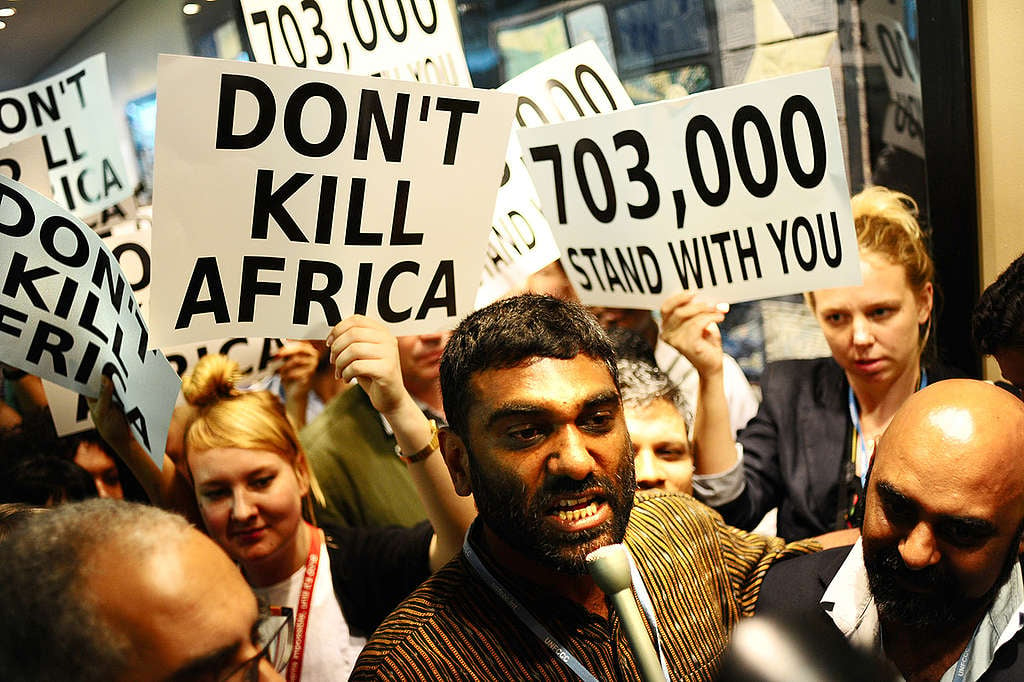30 November 2020, Johannesburg — The Department of Environment, Forest and Fisheries’ (DEFF) announced Monday to pursue criminal prosecution against Eskom for non-compliance with air pollution standards and supplying false and misleading information in reports to an Air Quality Officer at the Kendal Power station, between 2018 and 2019. In response, Greenpeace Africa Climate and Energy Campaigner Nhlanhla Sibisi has said:
“Kendal’s power plant is among many pollution bombs that has earned Kriel, Mpumalanga the title of a global hotspot for SO2 emissions, the largest hotspot in Africa and the largest hotspot driven by coal combustion worldwide. While it is commendable that the department has finally woken up to a realisation of the air pollution crisis facing South Africa, this decision is well within the department’s mandate and far overdue. Greenpeace Africa urges the department for increased enforcement of the standards across the industry to safeguard the constitutional rights of all South Africans to a healthy environment.
“Eskom’s internal investigation report which revealed that Eskom provided false and misleading information to the regulatory authority confirms Greenpeace Africa assertions that Eskom’s rampant corruption, maladministration, and blatant negligence are costing South Africans their lives. South Africa’s state utility has once again been proven to prioritise profit over the wellbeing of South Africans it claims to serve.
“Greenpeace Africa is aware that while this particular case will focus on Kendal power station, there are numerous instances of air quality exceedances beyond this specific plant and including numerous other carbon majors which must not be overlooked.
“Greenpeace Africa reasserts demands made in both its June 2019 report “Eskom: A roadmap to powering the future” [1] and its November 2020 SO2 report [2]”. And for a coordinated crackdown on all non-compliant air polluters”.
ENDS
Notes
[1] In a Greenpeace report released on 11 June 2019, Greenpeace expanded on and put forward a radical but practical option. The report “Eskom: A roadmap to powering the future” presented a roadmap with solid options for the country’s electricity supply industry crisis. The press release can be found here.
Key recommendations from the report include:
- The gradual phase-out of coal-fired power generation from Eskom to new generation companies (GenCos), which will operate the power plants for the remainder of their operating time on the basis of precisely defined conditions (e.g. a coal phase-out by 2040).
- The refinancing of Eskom through the decommissioning of coal-fired power stations older than 40 years, and the sale of all remaining coal-fired power plants; with very strict conditions in terms of their compliance with existing air quality and environmental regulations, and clear timelines for their closure. In principle, it must be considered whether private companies should also be invited to buy shares of the coal plants, or whether only public companies should have the right to participate in the auctions for the plants.
- The retention by Eskom of the important role of the transmission system operator (TSO) with the possibility of operating its own grid-supporting (non-coal) power plants.
- The opening of the IPP auctions for renewable energies to Eskom as well in order to make it a significant part of the utility’s business model.
- The possibility for Eskom to participate in the newly created six regional electricity distributors (REDs).
- The opportunity for Eskom to create new services for end-use customers on the basis of the digitalisation revolution that is evolving all over the world.
[2] Greenpeace Africa Sulphur Dioxide (SO2) Pollution Hotspots in South Africa: 2019-2020 report of November 2020 outlines the following recommendations for Emissions Reduction
- The South African Government to halt all investment in fossil fuels and shift to safer, more sustainable energy sources, such as wind and solar,
- Minister of Environment, Forestry and Fisheries, Barbara Creecy to strengthen SO2 emissions standards by reinstating South Africa’s 500 mg/Nm3 minimum emission standard and applying flue gas pollution control technology at power plants, smelters, and other industrial SO2 emitters,
- South Africa’s National Air Quality Officer, Dr Thuli Khumalo, to enforce existing minimum emission standards, South African Government and that coal-fired power stations or units that cannot comply with existing standards be decommissioned,
- The South African Government to implement an air pollution action plan for Mpumalanga, Johannesburg, Pretoria and all high priority areas that:
- aligns with the World Health Organisation (WHO) Air Quality Guidelines for ambient air,
- implements concrete measures and takes decisive action to improve the air quality in the regions and ensure compliance with South Africa’s Minimum emission standard within the next five years, and
- installs independent continuous emissions monitoring systems (CEMS) and receptor monitoring in the affected communities for different pollutants, making the data available to the public and informing decision making,
- Minister for Mineral Resources and Energy Gwede Mantashe to revise the commitments made in the Integrated Energy Plan and,
- abandon plans for installing new coal-fired power stations of 1500 MW capacity scheduled for 2023 and 2027, and
- increase uptake and implementation of renewable energy generation capacity through radical and deliberate policies and programmes
- the South African Government to ensure the development of a comprehensive and inclusive Just Transition programme that moves the country away from the use of fossil fuels to cleaner and sustainable energy.
[3] Greenpeace Africa has responded to Eskom’s application for postponement from compliance with Minimum Emissions Standards previously. The Press Release can be found here.
Contact details
Mbong Akiy Fokwa Tsafack: Head of Communication Greenpeace Africa, 071 688 1274,
 Get Involved
Get Involved
